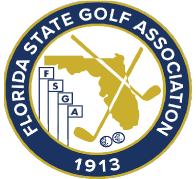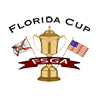
When playing a course with raised cup liners - such that the ball cannot be holed:
-
If a player hits the raised cup liner with their ball at a reasonable speed and the ball would have likely been holed if the cup liner was not raised - then the stroke should be treated as holed for posting purposes.
-
If the player hits the raised cup so hard that it is unlikely that the stroke would have gone into a normal cup, then one additional stroke should be added to the hole for that player.
-
A ball just barely hitting the edge of a raised cup, that would likely not have gone into a normal cup - the player should add an additional stroke for posting.
USGA's Official Guidelines
FLAGSTICK
May a course remove all flagsticks to minimize the possibility of exposing players to coronavirus?
May a committee introduce a code of conduct that does not allow players to remove (or even touch) the flagstick?
-
The flagstick serves an important purpose in the game of golf – that is as an indicator to a player as to where the hole is located on the putting green or a target for shots.
-
If a Committee decides to set-up a golf course without flagsticks, consideration should be given as to how best to support such a decision by providing players the location of each hole on the green. Whether this is general guidance (such as in the right front portion) or through a detailed hole-location sheet.
-
As another means of minimizing exposure to players, a Committee might decide to introduce a code of conduct that prohibits players from touching or removing the flagstick. As is authorized under Rule 1.2b, such a code could also include penalties (such as one penalty stroke or the general penalty) if a player is in breach of its standards.
-
Before a Committee decides to introduce such a restriction, it is recommended that consideration be given to the fact that removing the flagstick is an instinctual, even automated, act for many players. Drafting such a code of conduct to restrict only deliberate acts to affect the outcome of the hole would be reflective of that reality and would mean that a player who instinctually removes the flagstick would not get a penalty in doing so.
-
If a Committee takes any of the above actions, it is at the discretion of the Committee whether scores would be acceptable for handicap purposes.
BUNKERS AND BUNKER RAKES
We have removed all bunker rakes from our course to help stop the spread of coronavirus. What options do we have for players who end up in unraked areas?
-
By removing rakes from the course, the Committee has various options as to how best to address the likely possibility of a player’s ball coming to rest in an unmaintained area of sand and should consider which is the best approach under your unique circumstances.
-
If you have limited play and most players at your course use a golf cart, the best approach might be to ask that each player takes a rake with them.
-
If it is decided that no additional Rules will be put into effect to deal with these areas, it would be advisable to strongly encourage that players try their best to smooth the disturbed area with a foot or a club.
-
Additional options could include changing the status of bunkers to be part of the general area. This would give players additional options under multiple relief rules (Rules 16 and 19) and would remove the restrictions normally in effect under Rule 12.
-
Ground under repair could be used in two different manners. The first being to declare all bunkers to be ground under repair and treat them as part of the general area. This would allow players the option to take free relief outside the bunker under Rule 16.1. The second is to treat disturbed areas only as ground under repair. This would still allow a player free relief from such areas, but would require such relief to be taken elsewhere within the bunker.
-
As a last resort, we have fielded questions as to whether a Committee may add a preferred lies local rule that would allow a player to place the ball elsewhere in a bunker without penalty (such as within one club length of where the ball came to rest). While that may seem like a good option in that it requires players to play from the bunker, there will be times when no effective relief would be available to a player, such as when a bunker is frequently played from and large areas are unraked. It would be recommended that the other options, such as those listed above are considered first, noting that using the ground under repair options above ensure a player will get full relief and when dropping from knee height, balls very rarely plug.
-
If a Committee takes any of the above actions, it is at the discretion of the Committee whether scores would be acceptable for handicap purposes.
SCORECARDS AND SCORING
We are holding a competition, but want to limit how scorecards are exchanged both between players and after the round to the Committee. Do you have any recommendations?
-
The Rules already allow numerous options to address these concerns noting that certifying a score does not require a physical signature, nor does it require a physical scorecard.
-
If a Committee wishes to run a competition using a form of electronic scoring, this could come in many forms, such as asking that each marker send an email to the Committee and the player he or she is marking for, including the player’s hole-by-hole scores. The player can then reply to verify the accuracy of the card.
-
When electronic methods are used, such as the email example above or similar methods that involve text messaging, the Committee should decide when a scorecard would be considered to have been returned. For example, this could be when the player responds certifying that the scores are correct or some other action that the Committee might consider more appropriate.
-
A Committee might also wish to employ the above method but also combine these with a physical scorecard by having the marker take a picture of the completed scorecard and either email or text it to the Committee using the same process described above.
-
If physical scorecards are the preferred method, a Committee may wish to have the player and marker not exchange cards but rather verbally communicate the hole-by-hole scores to the Committee verbally in the scoring area. Additionally, verbal confirmation could be a substitute for the physical signature. As with the electronic scoring methods described above, the Committee should be diligent to clearly define when a scorecard has been returned, such as when a player leaves the golf shop if that is where the process takes place.
-
If a Committee takes any of the above actions, it is at the discretion of the Committee whether scores would be acceptable for handicap purposes.
MODIFCIATIONS TO THE HOLE; NOT REQUIRING THAT PLAYERS HOLE OUT
A number of questions have been received that relate to modifying the hole so that players no longer need to reach into the hole to remove a ball to minimize the possibility of exposing golfers to coronavirus.
These have included some courses setting holes so that the hole liner remains an inch or two above the surface of the green while others have placed various objects into the hole or around the flagstick (such as foam pool noodles or plastic piping) so that a ball is unable to fall to the bottom.
While in all of these instances, the ball is not holed per the Rules of Golf (Rule 3.3c), a round played under these conditions will result in an acceptable score for handicap purposes using the most likely score guidelines (see Rule 3.3 of the Rules of Handicapping).
While the most likely score procedure is intended to support certain formats of play where the player is not required to hole out (such as in match play when the player’s next stroke is conceded or in fourball stroke play when a partner picks up), it is also temporarily in effect where the above described safety measures are being used.
When using most likely score, the player should consider the number of strokes most likely required to complete the hole, and determine whether the ball would have been holed or not. Most likely score is at the player's best judgment and should not be used to gain an unfair advantage.
This measure is temporary and in effect within the United States until advised otherwise by the USGA.
The above guidance will continue to be updated.
Rules and Handicapping Guidance During COVID-19 Era





